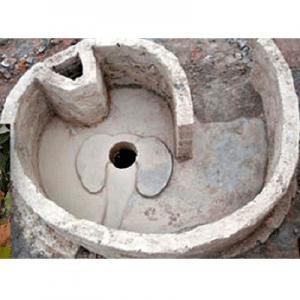
Agriculture
January 19, 2024
Clean Team Toilet and Clean Team Toilet Waste Management Service
Read SolutionImplemented by
Clean Team Ghana

Updated on January 17, 2024
·Created on October 1, 2018
The Tiger Toilet is a pour-flush pit latrine toilet that uses vermifiltration to treat waste.
The Tiger Toilet sanitation technology consists of a bathroom superstructure and a pit-biodigester employing vermifilration technology. The vermifiltration technology uses earthworms to decompose the waste from latrines rapidly into vermi-compost, while liquids drain out of the system. The Tiger Toilet is currently being developed and sold by EaSol Pvt Ltd.
Target SDGs
SDG 6: Clean Water and Sanitation
Market Suggested Retail Price
$350.00
Target Users (Target Impact Group)
Household
Distributors / Implementing Organizations
The original designer, Bear Valley Ventures, partnered with local organizations to distribute and install Tiger Toilets across India, including PriMove, Tata Foundation, and LIGGT. Currently the technology is developed and sold by EaSol Pvt Ltd.
Competitive Landscape
Direct competitors include Vermicomposting.
Countries
India, Uganda
Manufacturing/Building Method
The Tiger Toilet superstructures are constructed with concrete using a designed cast. The vermifiltration technology, consisting of tiger worms, bedding material and drainage material, are installed into a excavated pit (sized for the population of users). All materials can be sourced locally by the manufacturer and the users.
Intellectural Property Type
Trademark
User Provision Model
The manufacturer currently sells and installs Tiger Toilets across India in addition to providing support to monitor performance every 3-4 months.
Distributions to Date Status
Over 4500 toilets have been distributed by TBF Environmental Solutions.
Toilet type
Pit latrine
Evacuation method
Pour flush or dry
Storage conditions
Pit
Capacity (L)
Varies
Time until emptying
~5 years
Design Specifications
The Tiger Toilet system was designed to counter the problem of latrine filling through vermifiltration. This passive process degrades and recycles waste by integrating composting worms, bedding materials, and a drainage layer into a pit latrine. In this design, vermifiltration has resulted in 100% degredation of faecal solids, leaving 15% of the waste weight remaining in the pit in the form of vermi-compost. The optimal design produced with the Tiger Toilet results in an average COD removal of 87% and a 99% reduction in pathogens.
Technical Support
Provided by the manufacturer.
Replacement Components
Replacement components for the toilet superstructure can be sourced locally. The biodigester pit does not include any moving parts thus minimizing the need for replacement components.
Lifecycle
The pit of a Tiger Toilet can operate for five years without requiring emptying.
Manufacturer Specified Performance Parameters
The tiger toilet aims to reduce construction cost, eliminate energy input required for the self-regulating digestion ecosystem, and provide safer user operation because the handling of sludge is not required. There is less maintenance than traditional pit latrine, and no need to connect to a central sewer system.
Vetted Performance Status
The technology utilized in this product was shown to be feasible and that the presence of worms increased the faecal reduction rate. Testing by Bear Valley Ventures has found that the worm-based digester can allow for household-scale pits to operate for five years without needing to be emptied because worms reduce solids by over 80%.
Safety
The Tiger Toilet system was designed to enable the safe removal of vermi-compost and to prevent the handling of undigested waste by humans. To ensure safety, users must be instructed to not handle the undigested waste immediately after it is deposited into the pit.
Complementary Technical Systems
The Tiger Toilet is mainly sold as both the toilet superstructure and the biodigester; however the vermifitration biodigester technology can be purchased independently and coupled with existing toilet technology and superstructures.
Academic Research and References
Furlong, C. et. al., 2015, The development of an onsite sanitation system based on vermifiltration: the ‘Tiger Toilet’, Journal of Water, Sanitation & Hygiene for Development 5 (4): 608–613.
Furlong, C. et. al., 2014, The Tiger Toilet: From Concept to Reality. IWA specialist conference on Municipal Water Management and Sanitation in Developing Countries.
This paper discusses general information about vermifiltration:
Furlong, C. et. al., 2014, Processing of human faeces by wet term filtration for improved on-site sanitation, Journal of Water, Sanitation & Hygiene for Development 4(2): 231.
McCarthy, J., Sánchez, E., 2019, The Toilets of the Future Are Filled With Poo-Eating Worms, Gloval Citizen.
Compliance with regulations
Unknown
Evaluation methods
The Tiger Toilet system was evaluated based on environmental impact on digester worms, system configuration’s impact on effluent quality, and functionality during scaling. The treatment process utilized by this product underwent a feasibility assessment.
Other Information
The Tiger Toilet has received numerous awards.
List of frequently asked questions about the Tiger Toilet.
USAID - Report: Program review - Uganda

Agriculture
January 19, 2024
Implemented by
Clean Team Ghana

Agriculture
August 8, 2024
Implemented by
Patrick Kiruki, Banza Sanitation

Agriculture
August 13, 2024
Implemented by
The Africa Trust

Agriculture
August 17, 2024
Implemented by
Sanergy

Agriculture
August 13, 2024
Implemented by
Sun-Mar

Agriculture
December 20, 2023
Implemented by
Loowatt

Agriculture
December 20, 2023
Implemented by
Dry Flush

Agriculture
December 21, 2023

Agriculture
January 17, 2024
Implemented by
Centro de Desarrollo del Habitat y el Medio Ambiente (CEDES/Habitat)

Agriculture
August 16, 2024
Implemented by
Ecoloo
Have thoughts on how we can improve?
Give Us Feedback